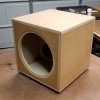To go along with the fun “Little Joker” coaxial speakers I built for patio use (described in this thread), I built a 12” sealed subwoofer to fill out the bottom end in the outdoor system. The idea was to keep the price down and make the woofer as resistant to weather conditions as possible for a decent price. Since I am using a great Dayton Audio mini 2.1 Class-T amp with 50 W per stereo channels and 100W into the woofer, I made this subwoofer passive without an amp or crossover.
I waited until I received the woofer and measuring it’s parameters before I designed the cabinet to ensure I get the best results. With inexpensive drivers, such as this one, the spec sheet parameters are not always the same as the delivered driver. This driver was fairly close to the factory specs, but I did have to adjust the volume of the enclosure by about 7% from the recommended design from the seller.
So, with a solid design in mind, I built and finished the enclosure, which I chose to make with equal sized parts to make cutting the panels easier. That led to an enclosure which is a perfect 15.5 inch cube. Nice!
I used an old input terminal cup I had in a drawer, as well as the cutouts from speaker holes in other projects to make the feet to lift the down-firing woofer off the ground. The predicted response said I should have a -3dB point of about 53Hz and a -10dB point (the effective bass limit) of about 35Hz. In reality it was just slightly deeper in the range, but not enough to make a huge difference.
 Photo 1: Subwoofer installed and tuned up
Photo 1: Subwoofer installed and tuned up
I’ll post a bunch of photos in the following posts along with measured performance and several comments.
I waited until I received the woofer and measuring it’s parameters before I designed the cabinet to ensure I get the best results. With inexpensive drivers, such as this one, the spec sheet parameters are not always the same as the delivered driver. This driver was fairly close to the factory specs, but I did have to adjust the volume of the enclosure by about 7% from the recommended design from the seller.
So, with a solid design in mind, I built and finished the enclosure, which I chose to make with equal sized parts to make cutting the panels easier. That led to an enclosure which is a perfect 15.5 inch cube. Nice!
I used an old input terminal cup I had in a drawer, as well as the cutouts from speaker holes in other projects to make the feet to lift the down-firing woofer off the ground. The predicted response said I should have a -3dB point of about 53Hz and a -10dB point (the effective bass limit) of about 35Hz. In reality it was just slightly deeper in the range, but not enough to make a huge difference.
 Photo 1: Subwoofer installed and tuned up
Photo 1: Subwoofer installed and tuned up I’ll post a bunch of photos in the following posts along with measured performance and several comments.









